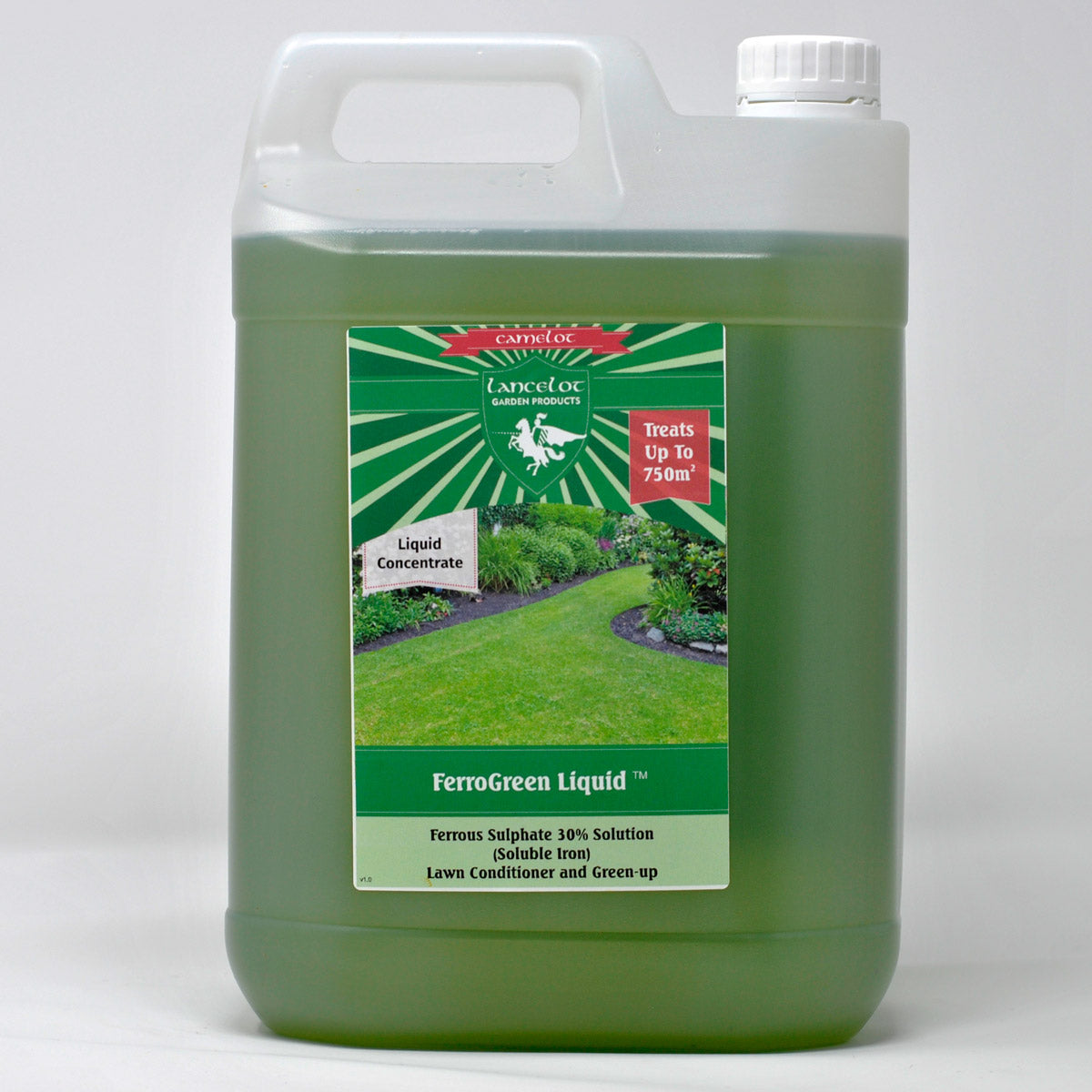

30% FERROUS SULPHATE SOLUTION
IRON (II) SULPHATE SOLUTION (6% Fe)
Technical grade
- A concentrated solution of ferrous sulphate containing 6% of active Iron (Fe)
- Product has been filtered during production to enable use through sprayers without clogging nozzles.
- Easy to use and user friendly - Eliminates the need to dissolve ferrous sulfate powder. No mess, no fuss.
- 5L treats between 250sq m and 750sq m
- Liquid application allows more accurate treatment and helps to prevent burning grass commonly found when using dry powder.
- Produces healthier, greener, tougher grass and is the ideal conditioner and tonic for lawns and turf - As well as the perfect treatment against Moss, Iron chlorosis and diseases.
- Very fast acting - visible results within a couple of hours - and within a few days, greener, healthier grass.
- Excellent for use of lawns, pitches, bowling greens, golf courses, Parks, etc. The perfect product as used by Professionals.
- Can be used throughout the year
USES FOR IRON SULPHATE
- It is used as a lawn conditioner and fertilizer. See below for more details.
- It is the main active ingredient in many commercial moss killer products as it will will turn moss black.
- Industrially, ferrous sulfate is mainly used as a precursor to other iron compounds.
- It is a reducing agent, mostly for the reduction of chromate in cement.
- Used in the manufacture of inks including iron gall ink.
- It is used a mordant for wool dyeing.
- Ferrous sulphate can also be used to stain concrete and some limestones and sandstones a yellowish rust color.
- Woodworkers use ferrous sulfate solutions to color maple wood a silvery hue.
In horticulture it is used for treating iron chlorosis (yellowing of folliage caused by iron deficiency). Although not as rapid-acting as iron chelate, its effects are longer-lasting. It can be mixed with compost and dug into to the soil to create a store which can last for years. Ferrous sulfate is sometimes added to the cooling water flowing through the brass tubes of a turbine condenser. It forms a corrosion-resistant, protective coating on the inside of the tube.
It is used as a traditional method of treating wood panels on houses, either alone dissolved in water or as a component of water-based paint.
Treatment Application Rates for Lawns
Rates of application can vary greatly depending on the desired effect and on the specific lawn. No two sets of circumstances will be the same and therefore a small area should be tested to satisfy yourself of suitability.
For Hardening and Conditioning Lawns
Test a small area with a 3% Ferrous Sulphate Heptahydrate solution (ie. 30mls/1L of water). If this does not give the desired effect a stronger solution can be used up to a maximum of 15% Ferrous Sulphate Heptahydrate (150mls/1L of water ).
A typical application for greening of grass would be 30ml-60mls per Litre. Be aware that at dilutions of 150mls per Litre and higher, blackening of moss will occur. It is for this reason that Ferrous Sulfate is often included as an active ingredient in commercial lawn moss killing products. Over application of the product could also result in blackening of the grass itself.
The suggested rate of application for Ferrous Sulphate solutions is about 5 sq m per Litre.
Please be aware that Ferrous Sulphate solution will cause staining if spilt or applied to hard surfaces such as concrete. These brownish stains are effectively a form of rust and to remove them one will need to use an acid solution like Oxalic acid (used as a 5% solution).
When treating lawns with ferrous sulphate keep pets off the surface for at least one week. This protects their well-being and prevents transfer of residues onto hard surfaces (i.e. brown staining).
For application on agricultural pasture land / paddocks etc use at the same rates as above. Animals like horses must be kept of grasslands for at least 4 weeks before being allowed back to graze.
An over usage of Ferrous Sulphate can be harmful if the land being applied to has a low pH (Acidic) as Ferrous Sulphate is naturally acidic with a pH of 2.5. It is also recommended that the entire lawn be treated rather than specific areas to prevent certain patches becoming more acidic than others.
NOTE: We must stress that this information can only be used as a guideline and is given in good faith. We cannot be held responsible for any adverse effects that may be experienced as a result of use of the above product.
Acidifying Soil - Reducing pH with ferrous sulphate:
To reduce the pH of soil by 1 unit eg. to reduce a pH7 to a pH6 would require 6.75L to 13.5L of ferrous sulphate solution per 100sq feet of soil. This should be dug into a depth of 6 to 10 inches.As the acidification occurs as the ferrous sulphate is biologically degraded this can take several months so the process of acidifying is gradual. As it is important to avoid building up too much iron in the soil it is suggested that one should wait for 12 months before testing the pH again and repeating the process if necessary.
Health & Safety
R-Phrases: R22 Harmful if swallowed. R36/38 Irritating to eyes and skin.
S-Phrases: S46 If swallowed, seek medical advice immediately and show container or label.
PLEASE NOTE: This product is not for human or animal consumption.


